Author: Heidi Cohen / Source: Content Marketing Institute
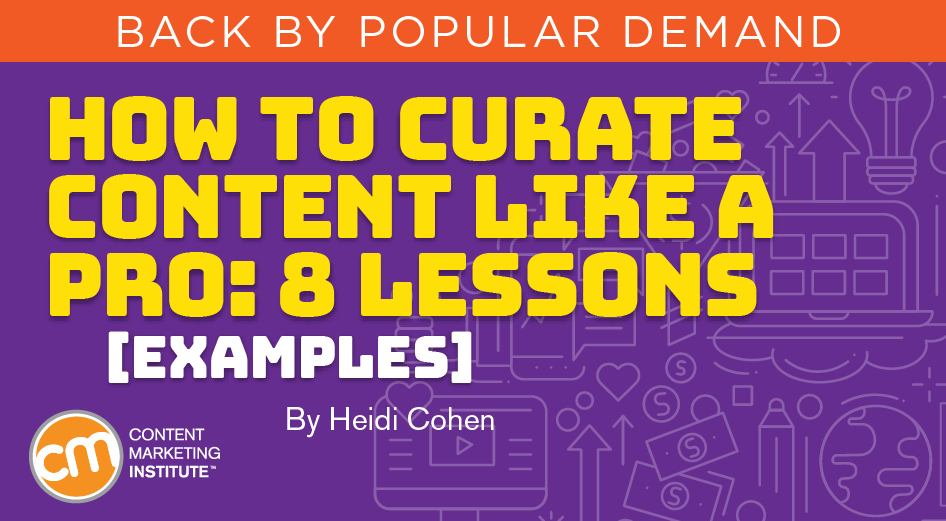
Editor’s note: Even if you read this title when CMI published it three years ago, you’ll find the updated information and new examples helpful to your content curation.
Content curation taps into the power of existing owned, social, and third-party media to enhance and extend your content marketing resources.
This doesn’t mean content curation is free.
Rather, curated content is more cost effective than brand-spanking-new content. Even better, content curation enables you to maximize the full potential of existing content across your organization.
To ensure that we’re on the same page, here’s my content curation definition:
To meet your audience’s information needs, content curation is the assembly, selection, categorization, commentary, and presentation of the most relevant quality information. You add your human editorial perspective while integrating your 360-degree brand.
While saving your audience valuable time, content curation isn’t a cheap substitute for original content creation. Rather, content curation yields measurable benefits aligned with your business goals. It:
- Fills your editorial calendar with quality content from a variety of voices
- Extends the life of existing content across your organization, including non-marketing information
- Supports ongoing content amplification and distribution
By contrast, content aggregation is the compilation of information, references, or links. While it looks like content curation, content aggregation lacks unique editorial input and commentary.
While most content marketing research no longer tracks the use of content curation as a separate category, Jebbit’s Jenna Keegan recommends marketers ideally strive to curate 25% of their content.
Based on my experience, marketers can use content curation at least once a month or as frequently as once a week. Here’s how a monthly content curation plan might look:
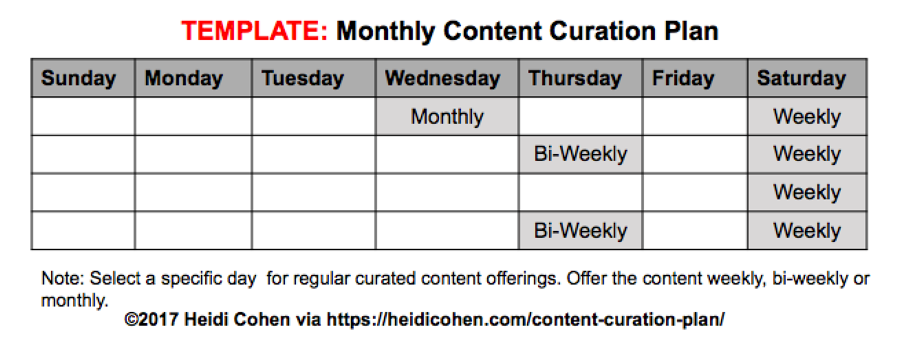
8 ways to curate content like a pro
To curate content that breaks through the information clutter to support business objectives, here are eight ways the pros use content curation to yield measurable results.
1. Spotlight the best of the week’s news
Curating the news provides a useful service for your audience. It highlights key events and changes your niche that they need to stay current. Christopher Penn does this with his weekly curated email newsletter, Almost Timely News.

In the Almost Weekly News, Christopher organizes curated links across a consistent set of categories. While focused on marketing, he includes other categories that add depth to the content such as:
- Good Reads, Long Reads, Interesting Stuff
- Fun, Games, and Entertainment
- Economics, Politics, and Society
Christopher includes an introduction with his commentary on the week’s events. This editorial distinguishes his content curation from aggregation.
Christopher Penn’s pro content curation process
Key to content curation success: Human judgment. (HINT: You should incorporate editorial decision-making too.) Vet the information you curate to ensure that it’s valuable to your audience.
Curate your content in small batches to simultaneously support your daily content and social media efforts.
Each day Christopher identifies the top content he finds interesting or useful by checking the top shared content on Twitter and LinkedIn. (His audience is B2B, so your focus may vary.)
Due to his skill set, Christopher’s curation process is more technical than most content creators’. He uses a suite of SEO and social media analytics tools as well as custom-built software to clean up his social shares and prepare the content for the newsletter.
Actionable content curation tips:
- Brand your curated content. He uses a consistent email header image. It’s an interesting combination of mousetraps revealing his sense of humor.
- Organize the information to help audience consumption. Make your content curation more than a link dump.
- Add value for your audience in the form of editorial commentary. Include your personal insights like Christopher does.
- Incorporate marketing promotion with care. Christopher announces his books, speaking engagements, and product offering in his newsletter. He’s earned this right by consistently offering quality content curation. The promotion is clearly defined as “advertising” so that the editorial line isn’t blurred.
2. Develop a cyclical curation column to fill your editorial calendar
Provide your audience with regular content servings to develop content anticipation. This is even more important in an era where appointment media has disappeared.
Spin Sucks’s Gini Dietrich’s pro content curation process
Create cyclical content your audience looks forward to consuming.
It’s relatively easy to create regardless of your content resources with an established content curation format.
For example, the Spin Sucks editorial calendar includes two weekly content curation columns: Gin and Topics for YouTube videos and The Big Question for Slack group discussions. Gini points out that these curation columns broaden the blog’s reach.
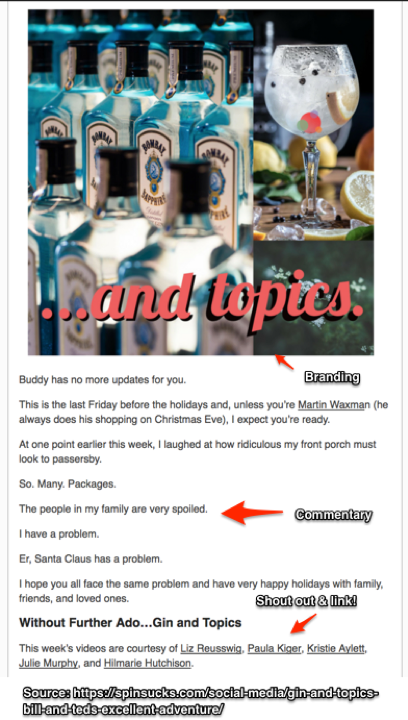
At the start of Gin and Topics, Gini used her personal Facebook and Twitter accounts to ask her community to send her videos they thought were funny. Initially it was time consuming, but after three months people started submitting videos on their own. She still includes a reminder at the end of every column to forward videos.
Gini has evolved to using the Spin Sucks Slack group’s Gin and Topics channel to collect video links. On average, she receives 10 to 15 videos per week from which to choose.
In true pay-it-forward social media style, Gini gives people credit for the videos they forward by linking to a piece of their content.
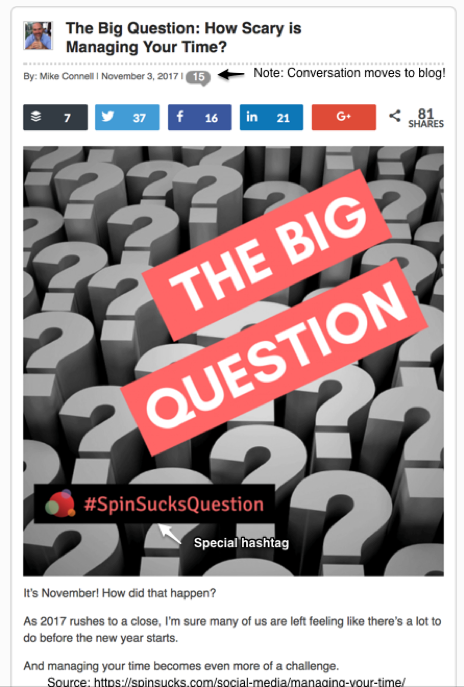
For The Big Question, Gini posts the week’s question in the Slack channels and on social networks. Additionally, she posts it in HARO (a regularly distributed email and website where content creators can seek sources for their articles that’s distributed to thousands of PR-type professionals), bringing in new readers and subscribers.
Actionable content curation tips:
- Develop a tailored cyclical curation content format for your audience. It facilitates content creation on a regular publishing schedule. While Gini’s Gin and Topics took time initially, it’s relatively low-maintenance to create on a weekly basis.
- Get your community involved in your content curation. Ask your social media communities to spotlight content they think is worthwhile. When the piece is published, they’ll share with their networks, which helps your distribution.
- Think beyond your curated content. Build your community by paying it forward with mentions and links. Also by tapping into other people’s communities such as HARO.
- Brand your curated content columns. Act like a media entity to create ongoing columns that are recognizable to your audience. Craft a consistent title and graphic like Gini did.
3. Get your audience and staff involved
With a small editorial team also responsible for marketing materials, Contently uses content curation to maximize productivity, according to Editor-in-Chief Jordan Teicher.
Contently’s Jordan Teicher’s pro content curation process
Jordan incorporates content curation into Contently’s brainstorming meetings. For example, he asks his team to find existing studies about which they can say something new.
Spotlight your internal expertise. Jordan also taps into organizational expertise with the use of brief questionnaires. They ask employees to share their predictions and tips that the editorial team gathers and synthesizes into a listicle or infographic.
While curation is an important part of Contently’s offering, truly original content is the core of its strategy. According to Jordan, Contently aims for a ratio of 75% original content and 25% curated content. But, curated content is always viewed through some lens of originality.
Actionable content curation tips:
- Be original even if it’s curated content. If you regurgitate someone else’s work without adding your perspective, you won’t benefit from it. Even if an individual article does well, the audience won’t care that it came from you.
- Figure out how your analysis or opinion complements a report from another publisher. Similarly, if you’re collecting quotes from leaders in your industry, ask them questions they haven’t heard. Don’t reinvent the wheel, but reimagine the source material.
4. Incorporate your existing content into new content to keep it visible
“For my role with Content Marketing Institute, curation is viewed as a holistic process — it flows through all of the content produced by the editorial team, and is treated as part and parcel to CMI’s overarching content marketing strategy,” according to Jodi Harris.
Jodi doesn’t solely view curation in terms of individual content assets such as blog posts, newsletter content, or videos. Instead, she assesses how to amplify content that is already resonating, so that its value and usefulness can be extended to new audiences.
Content Marketing Institute’s Jodi Harris’s pro content curation process
Repackage multiple posts into “essentials” guides on the topic. “How to Deliver Emails That Will Increase Reach, Impact, and Subscriber Satisfaction” is a prime example.
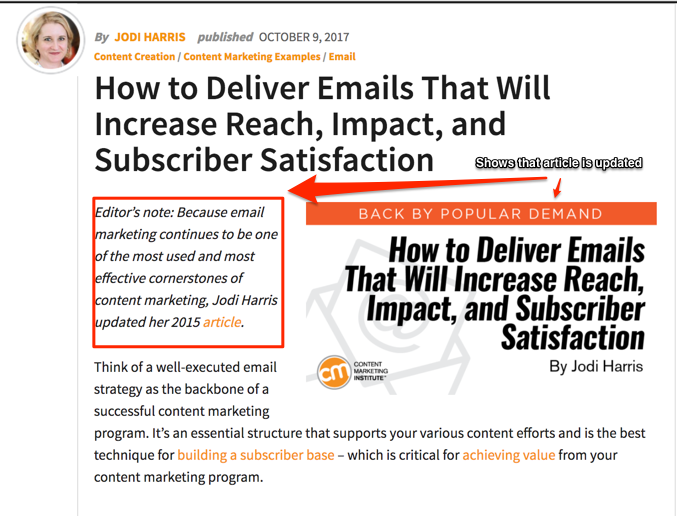
Repurpose a key component of a popular post into a new format such as a checklist, an infographic, a data visualization chart, or social media posts.
To identify high value assets and efficiently turn them into curated content on an ongoing basis, Jodi shares a few tips that have served her well:
- Monitor initial performance of all content. This includes examining search traffic over time to determine the long-tail potential of high performing content. If a piece of content still drives good search traffic after six months of publication, it’s likely a topic…
Audience Team
The digital audience insights you need to build, manage and market to your digital audiences.

